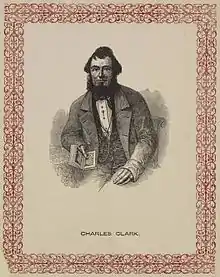Charles Clark (publisher, born 1806)
Charles Clark (1806–1880) was an English publisher, farmer and satirist.[1]

Life
He was the son of Robert Clark (died 1850), a farmer, and his wife Mary Ann Pond (died 1849), and was born at Heybridge, Maldon in Essex. He attended a school in Witham run by James Salisbury Dunn.[2]
Clark started farming with his father, and they moved to Great Totham in 1823.[2] He was writing poetry by the mid-1820s, and set up a press by 1828. George William Johnson who lived in the village published his History of the Parish of Great Totham (1834) with Clark. Most of what he printed were parodies and songs, generally "exceedingly silly and indecent" according to Gordon Goodwin in the Dictionary of National Biography. Clark imitated the poet Thomas Hood, and in one case was threatened with legal action.[3][4] That was caused by a poem of 1839, A Doctor's 'Do' ings, on the marriage of Dr Henry Dixon.[5]
An associate of Clark was the printer Philip Henry Youngman (fl.1826–1851), in Witham and Maldon.[6][7] Other productions from Clark's private press were reprints of tracts and old works, including one by the Tudor agricultural writer Thomas Tusser. Clark was given support in this direction by John Russell Smith.[2]
In later life Clark moved back to Heybridge, and in the 1860s became reclusive. He died unmarried on 21 March 1880, and his press and library were auctioned.[2]
Bibliography
He wrote pseudonymously the following:

As C. C.:
- The Song of the Brat
- The Old Bachelor
- Tiptree Races
As Chilly Charley or Snarley Charley:
- Bills, Ills and Chills
- Bagging and Bragging
As Doggerel Drydog:
- September, or Sport on Sporting
- Oh No! We'll Never Welcome Them!
As Charles William Duckett:
- Stanzas from 'The Lay of the Brokenhearts'
As Thomas Hood the Younger:
- Epsom Races
As Pe-Gs-Us:
- The Balloons
As Quintin Queeerfellow:
- A Doctor's 'Do' ings
See also
- McGill University Library has digitized 85 examples of his work from their William Colgate History of Printing Collection that can be accessed through their library catalogue and the Internet Archive.
References
- T.J. Carty (1 December 2015). A Dictionary of Literary Pseudonyms in the English Language. Routledge. p. 352. ISBN 978-1-135-95578-6.
- Oxford Dictionary of National Biography (online ed.). Oxford University Press.
{{cite encyclopedia}}: Missing or empty|title=(help) (Subscription or UK public library membership required.) - Baker, Anne Pimlott. "Johnson, George William". Oxford Dictionary of National Biography (online ed.). Oxford University Press. doi:10.1093/ref:odnb/14882. (Subscription or UK public library membership required.)
- Stephen, Leslie, ed. (1887). . Dictionary of National Biography. Vol. 10. London: Smith, Elder & Co.
- Carrie Griffin (6 October 2015). Readings on Audience and Textual Materiality. Routledge. p. 77. ISBN 978-1-317-32266-5.
- Carrie Griffin (6 October 2015). Readings on Audience and Textual Materiality. Routledge. p. 76. ISBN 978-1-317-32266-5.
- British Architectural Library. Early Imprints Collection (2003). Early printed books, 1478-1840: Catalogue of the British Architectural Library Early Imprints Collection. indices, supplement, appendices, addenda and corrigenda. K.G. Saur. pp. 3008–. ISBN 978-3-598-24058-4.
External links
- Finding Charles Clark 1806–1880. Not just another book collector
- The Salamanca Corpus, Charles Clark (1806–1880)
- Great Totham Press at briarpress.org